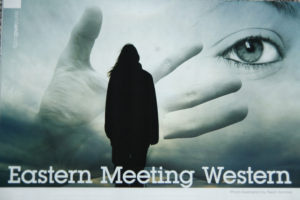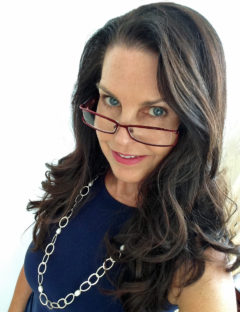![]() August 2009
August 2009
 Oh, my aching sacroiliac. My back’s SI joint had been shooting pain through my most basic motions: sitting, standing and sleeping. Like most people, I made a doctor’s appointment. The physician only took care of backs and wouldn’t even glance at my sore knee. “Might they be related?” I asked. After an evaluation, an MRI and physical therapy, I was released, and I guess, pronounced well. Except, I wasn’t. To pursue it further, I needed a pain management specialist. The tests said all my healthy individual parts should be working, so why the twinge?
Oh, my aching sacroiliac. My back’s SI joint had been shooting pain through my most basic motions: sitting, standing and sleeping. Like most people, I made a doctor’s appointment. The physician only took care of backs and wouldn’t even glance at my sore knee. “Might they be related?” I asked. After an evaluation, an MRI and physical therapy, I was released, and I guess, pronounced well. Except, I wasn’t. To pursue it further, I needed a pain management specialist. The tests said all my healthy individual parts should be working, so why the twinge?
I asked Licensed Acupuncturist Stephanie Selman how she could help. She said, “Acupuncture looks at you like a tree. I look at your limb, your roots, your wind and everything that affects that tree. This is Root and Branch Theory. Effectiveness depends on the practitioner and the patient who needs to feel open and tell the truth. Are you holding something in or are there addiction issues, reproductive problems…?”
For fifteen years, Selman has taken a quiet approach to finding answers to those questions that determine health. “A practitioner needs to read between the lines – a wall hiding pain can hinder health. People say ‘psychosomatic”’ like it’s bad, but everything has a mind and body connection.”
Next, Selman would look at my eyes, hair and tongue before taking my pulse in several places – all to check the kidney organ system which is responsible for joint and bone pain. “Traditional Chinese Medicine (TCM) is evidence-based in that I take in a lot of information to diagnose a problem. That points me in a direction,” she said. And if it pointed to the kidney? “I would do a treatment to support that organ as well as points around the SI joint to loosen you up.”
Same patient, same pain, yet the practitioners organized information, applied logic and treated the situation distinctly different. Each stems from a time-tested method. The central concept of TCM is qi (pronounced chee) and is seen as bio-electric energy in the West. It’s like the invisible substance in our mountain air that clears the mind in one breath.
Nurse Practitioner Michelle Inge had thoughts about my nagging back. “Fifty-percent of back pain is stress. You have a lot of options. At North Country Clinic, we expose patients to all the different modalities, providing individualized care,” she said. “That’s why I wanted an integrated team. I’m tired of fifteen minutes to assess and treat, and they’re gone. There’s so much more to medicine than that. Healthcare is evolving.” Inge has been putting alternative therapies into practice for eight years to educate and provide early intervention. “I’d rather fix little problems before they become big,” she said.
Western medicine acts on substance and cells while TCM acts on energy that animates those cells. Also trained in Reiki healing, Inge is able to do both. Reiki is healing touch. Qi gong. The laying on of hands. “The hands bring up chakra energy, but if you’re hard-headed, you could miss the whole point,” she said. “A person needs to want to get better. If they want pain pills, they can get them, but there are other ways to help them through physical, emotional and spiritual components. It’s all connected.”
So it is. The Japanese word generally translates to life or spirit (rei) and energy (ki). People report healing through sensations of cold or heat or pressure, and like acupuncture, it works to repair or open channels of energy flow.
The contrast of Eastern and Western practices is stark, but the goal of a growing trend of professionals is to educate others and combine them for care that allows the body to heal itself. Bettina Martin, M.D. said, “I’m part of a new generation of doctors – the kind I’d like to visit myself – with a broader perspective.” Dr. Martin sought out this path through a residency fellowship under Andrew Weil, M.D., Director at the University of Arizona’s Center for Integrated Medicine. The program introduces doctors to a variety of alternative practices that include: nutrition, psychology, supplements, homeopathy, TCM and much more.
Dr. Martin said, “I was trained in the style of practice I aspired to, right from the beginning. Integrated medicine looks at everything and embraces what works while rooting out questionable or dangerous practices…It is healing-oriented and patient-centered and takes account of the whole person – something that transcends distinctions of East and West.” She finds listening to people and taking the time to find out what they need is critical.
Industry growth in alternative therapies is steady, following the “natural” trend that inspires people to complimentary ways of caring for their health as well as the environment. In developed countries, one in two persons seeks out companion methods that include TCM.
Dr. Martin took additional training in Mind/Body Medicine and Acupuncture for Physicians at prominent schools to expand her capabilities. She said, “East meets West is about expanding our perspective toward something more global, and perhaps, more balanced, allowing new insights…Conventional medicine has a set of tools, but when we come to the end of what we do, I like having a few extra in my box. And that’s good for the patient and the physician.” NAMLM
Gail G. Collins
